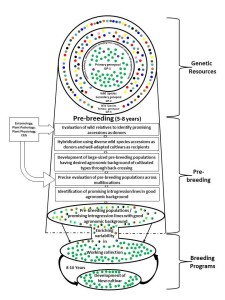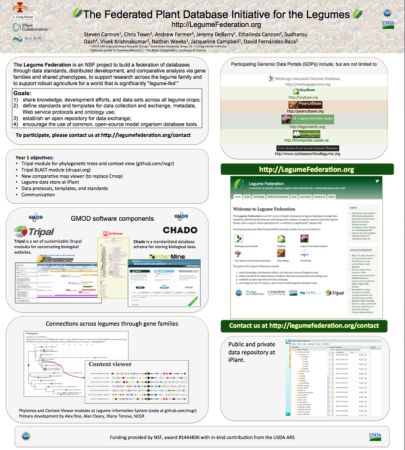- A database of how you do sustainable intensification.
- Building a better strawberry.
- New lab helps Bangladesh with high-zinc rice.
- Maybe those guys are you nutrition champions.
- They’re right, camel milk is good, and good for you.
- Useful list of Mike Jackson’s publications.
- Pres. Obama learns about maize in Ethiopia.
- Increased quinoa supply leads to lower prices shock.
- Silly season roundup: tiny watermelons (no, not really), tiny pineapples.
ICRISAT DG on the importance of genebanks
 There’s a great blog post up on the ICRISAT website from its new Director General, Dr David Bergvinson. It basically says, though not in so many words, that the centre’s germplasm collections are the foundation of all its crop improvement work. Which is nicely illustrated by this diagram (click to embiggen), from Dr Shivali Sharma, who’s a senior scientist in the genebank. You can see more photos of her (and others’) wide crossing and pre-breeding work at ICRISAT on the Flickr album I put together after my visit there a couple of years back.
There’s a great blog post up on the ICRISAT website from its new Director General, Dr David Bergvinson. It basically says, though not in so many words, that the centre’s germplasm collections are the foundation of all its crop improvement work. Which is nicely illustrated by this diagram (click to embiggen), from Dr Shivali Sharma, who’s a senior scientist in the genebank. You can see more photos of her (and others’) wide crossing and pre-breeding work at ICRISAT on the Flickr album I put together after my visit there a couple of years back.
Dr Bergvinson closes his post by pointing to ICRISAT’s 100 Voices video series, the first instalment of which is on genomics as a tool to make even better use of genebank collections.
Tweeting up a storm in Minneapolis and Pullman
What did we do before Twitter? Had a life, probably. But also, it was undeniably more difficult to keep up to date with stuff. Absent heroic tweeps in Minneapolis, I would not have been able to follow Plant Biology 2015 quite so assiduously, and thus find out about, among many other things, the Legume Federation. Or indeed see their poster.
Likewise the annual meeting of the National Association of Plant Breeders would have slipped me by. And I would have missed this photo of two plant breeding legends.
#NAPB2015. Two giants of wheat breeding whose shoulders we all stand on. Bob Allen and Cal Qualset–great people!! pic.twitter.com/po6PPvmW5b
— UNL Small Grains Breeding- Frels Lab (@Huskerwheat) July 28, 2015
Brainfood: Pepper tree conservation, Buckwheat diversity, Seed drying, Grape database, Livestock improvement, Soil bacterial diversity, TLB in Nigeria, Humans & diversity double, Faidherbia @ICRAF
- Genetic structure and internal gene flow in populations of Schinus molle (Anacardiaceae) in the Brazilian Pampa. Try to keep what forest patches remain. And link them up somehow.
- Genetic Diversity of Buckwheat Cultivars (Fagopyrum tartaricum Gaertn.) Assessed with SSR Markers Developed from Genome Survey Sequences. Two groups, overlapping in Qinghai, China.
- Increases in the longevity of desiccation-phase developing rice seeds: response to high-temperature drying depends on harvest moisture content. Genebanks may have it wrong for seeds of rice (and perhaps other tropical species) harvested while still metabolically active: these you can dry at higher temperatures than is the norm.
- Vitis International Variety Catalogue (VIVC): A cultivar database referenced by genetic profiles and morphology. Now with added microsatellites.
- Options for enhancing efficiency and effectiveness of research capacity for livestock genetics in, and for, sub-Saharan Africa. Embed in wider rural development, collaborate, and share data. Could apply to more than just livestock improvement.
- Mapping and validating predictions of bacterial biodiversity using European and national scale datasets. It’s the pH.
- Agricultural Extension Roles towards Adapting to the Effects of Taro Leaf Blight (Tlb) Disease in Nsukka Agricultural Zone, Enugu State. Basically, extensionists haven’t done a thing.
- Anthropogenic drivers of plant diversity: perspective on land use change in a dynamic cultural landscape. Abandoning farmland is not good for biodiversity.
- Agricultural landscapes and biodiversity conservation: a case study in Sicily (Italy). Ahem. Abandoning farmland is not good for biodiversity.
- Genetic diversity of Faidherbia albida (Del.) A. Chev accessions held at the World Agroforestry Centre. It’s not enough.
Nibbles: High science, Methane-friendly rice, Gender, Indian priestesses, Banana extinction, Inka legacy, Diversity in ag, Yerba genome, Cucumber chains, Tomato relative, Agrobiodiversity in art
- High-level agricultural scientists thinks high agricultural science will feed the world. Oh, and smart policies.
- This new rice would qualify, I suspect.
- Participatory varietal selection manual revised to take women into account. Someone mention high science?
- No such manual needed in India, it seems.
- The banana-is-doomed story sure has legs. Or hands.
- What did the Inkas ever do for us?
- Is agriculture diverse enough? That is the question.
- Yerba mate gets sequenced. Because it can be.
- Following an Indian cucumber down the value chain.
- Thank your lucky stars for this weedy-looking tomato wild relative.
- “We’re interested in the color, shape and sizes of the vegetables from 400 years ago, compared to modern cultivars of the same vegetables: the deep sutures on cantaloupe in Italian art of the Renaissance or the lack of pigmentation in pictures of watermelon compared to today.”
- Quite a bit of agrobiodiversity featured in Day of Archaeology. Nice idea.

